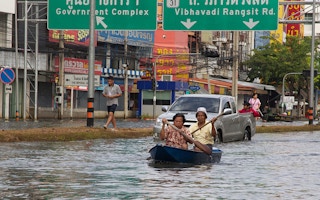As millions of people pour into East Asia’s cities each year, the region’s governments face the pressing task of easing the enormous strain on resources and infrastructure, and limiting residents’ exposure to disasters and climate change risks.
“In the future, two out of every three people will live in a city,” said Peter King, a Bangkok-based policy advisor for the Institute for Global Environmental Strategies (IGES).
“We have a choice to make now: do we want the cities to be pleasant, healthy, satisfying and vibrant places to live or do we allow the extra millions of people flocking to cities across the world to occupy vulnerable, dirty, dangerous slums, surrounded by the walled, guarded residences of the rich?” he said on the eve of a conference in northern Thailand to discuss the challenge in East Asia.
The two-day meeting will bring together some 200 experts from national and regional governments and academia, to explore solutions to issues such as reducing waste, partnering with the private sector on green projects, and strategies to achieve the UN-led Sustainable Development Goals (SDGs).
“
East Asia has some of the largest slum settlements in the world, so there is already a huge backlog of infrastructure and proper planning, exacerbated in future by the challenges of adapting to climate change and providing energy access for all.
Peter King, policy advisor, Institute for Global Environmental Strategies
The 17 global goals, launched last year, cover many things relevant to city dwellers, such as access to affordable and clean energy, decent work and economic growth. But one specifically calls for “sustainable cities and communities” that are inclusive, safe and resilient.
Saroj Srisai, head of environment at the ASEAN Secretariat, which coordinates the 10-nation Southeast Asia bloc and is one of the conference organisers, said implementing the SDGs “requires full cooperation among national government agencies, local authorities and development partners, which needs to be significantly strengthened”.
“We are learning good lessons from Japan’s experience dealing with urbanisation since the 1950s, especially in terms of balancing social and environmental concerns and the economy,” he added in emailed comments.
Southern Japan’s Kitakyushu City, for example, will showcase at the conference how it has overcome severe industrial pollution, while Toyama in central Japan has embarked on public transport planning to revitalise the city with an ageing population - a challenge Thailand is predicted to face in the coming decades.
Disaster deaths
King said the conference should focus on translating global aims like the SDGs into local action, by setting targets and commitments at all levels of government and initiating partnerships with a wide range of organisations.
Studies have shown that East Asia, home to an estimated 2.2 billion people, is urbanising rapidly, fuelled mainly by migration inside countries.
Almost 200 million people moved from rural to urban areas in East Asia between 2000 and 2010, a figure equal to the world’s sixth-largest country, according to a 2015 World Bank report.
East Asia’s urban areas include eight “megacities” with populations of over 10 million; 123 large cities of between 1 million and 10 million people; and 738 medium and small cities with 100,000 to 1 million people, shows the report, which analysed satellite imagery and population models to chart urbanisation.
Experts have made links between urbanisation and income growth, pointing to increased economic output per capita as the percentage of people living in urban areas has risen.
Yet urbanisation also tends to put a strain on resources as more people compete for space, jobs, water and energy. Badly planned, it can result in worsening pollution, waste and inequality, and higher exposure to disaster and climate risks.
Already the wider Asia-Pacific region is the most disaster-hit in the world, with over 2 million deaths from earthquakes, tsunamis, floods and other hazards between 1970 and 2014 - more than half of global fatalities during that period.
Despite its fast growth, only 36 per cent of East Asia’s population currently lives in urban areas, so the phenomenon of people moving to cities is likely to continue in the region for decades to come, the World Bank said.
IGES’s King noted that much of the developed world, including Europe, North America and Australia, has already made the transition - so the tens of millions of people shifting to cities in the next few decades will be concentrated in Asia.
“East Asia also has some of the largest slum settlements in the world, so there is already a huge backlog of infrastructure and proper planning, exacerbated in future by the challenges of adapting to climate change and providing energy access for all,” he added.
This story was published with permission from Thomson Reuters Foundation, the charitable arm of Thomson Reuters, that covers humanitarian news, climate change, resilience, women’s rights, trafficking and property rights. Visit http://news.trust.org/climate
The Thomson Reuters Foundation is reporting on resilience as part of its work on zilient.org, an online platform building a global network of people interested in resilience, in partnership with the Rockefeller Foundation.










